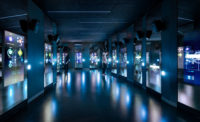As the only permanent structure built for the 1904 World’s Fair in St. Louis—an event which looms large in the collective consciousness of the city to this day—the Cass Gilbert-designed Palace of Fine Arts, later known as the Saint Louis Art Museum (SLAM), persists as a cultural and architectural icon. The handsome neoclassical pile sits atop a rolling hill in the town’s beloved Forest Park, where admission through its porticoed main entrance to view an encyclopedic collection has remained free for over a century.
Needless to say, alterations to the museum—including a patterned brick addition at the rear of the building and a distinctively postmodern Charles Moore-designed West Grand Stair—were met with resistance and controversy. British architect Sir David Chipperfield has largely been spared such polemics with his modest design for the new East Building, opening June 29.
Known for his rigorous design approach, Chipperfield was appointed unanimously by Museum commissioners in 2005 to design an expansion to SLAM. No stranger to merging old and new, Chipperfield received the prestigious Mies van der Rohe Award in 2011 for his restoration of the Neues Museum in Berlin. But unlike his other cultural projects in the U.S.—for the Figge Art Museum in Davenport, Iowa, and Alaska’s Anchorage Museum expansion—that feature predominantly glass facades, the St. Louis project, in what is perhaps its boldest design statement, is defined by dark, massive panels of polished concrete that contrast sharply with the light-colored masonry of the existing Beaux Arts structure.
The other defining feature of the one-story “pavilion in the park,” as Chipperfield calls it, is the 4’-deep concrete coffered ceiling containing skylights that provide daylight to almost all of the new building’s 21 galleries. Used primarily to display modern and contemporary art, the flexible galleries accommodate temporary walls and feature under-floor air distribution and hidden building services. HOK served as architect-of-record, working with Chipperfield’s office to achieve LEED Gold accreditation. Paris-based Landscape Architect Michel Desvigne is designing the museum campus, including a future sculpture garden, in phases.
The 211,000-square-foot addition—more than half of which comprises below-grade parking for 300 cars—increases the museum’s total gallery space by 30 percent. It also allowed for the renovation and reinstallation of 68 galleries in the Cass Gilbert building. Chipperfield’s intervention there was minimal, save for a new Grand Stair in the main entry leading to that structure’s lower level.
Chipperfield’s project is marked by deference to an illustrious past, both architectural and symbolic, but it is clearly a building of its time. It remains to be seen if his elegant restraint will bring the increased recognition this world-class institution in an oft-overlooked American city seeks.
















